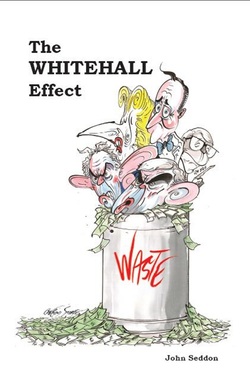The Whitehall Effect ~ John Seddon - Online Notes
|
Links below take you to the chapter notes:
Introduction 1. Prelude Part 1: The industrialisation of public services 2: Call centres 3. Back Offices 4. Shared Services 5. Outsourcing 6. Information Technology Part 2: Delivering services that work Introduction 7. A better philosophy 8. Effective change starts with ‘study’ 9. Better thinking, better design 10. ‘Locality’ working 11. IT as pull, not push Part 3: Things that make your head hurt 12. Targets and standards make performance worse 13. Inspection can’t improve performance 14. Regulation is a disease 15. It’s the system, not the people 16. Incentives always get you less Part 4: ideology, fashions and fads 17. Choice 18. Personal Budgets 19. Commissioning 20. Managing demand 21. Nudge 22. Procurement 23. Risk management 24. Lean 25. IT: features over benefits Part 5 Change must start in Whitehall 26. Beware economists bearing plausible ideas 27. Whitehall is incapable of doing evidence 28. Getting a focus on purpose |
11. IT as pull, not push
1] See a video where IT developers from a private sector organisation describe what they learnt from applying the Vanguard Method in their work. 2] John Seddon ‘Re-thinking IT’, recorded 11 November 2010 at Øredev developer conference, Malmö, Sweden . View Case studies have been published in: John Seddon and Brendan O’Donovan, 2012, ‘Process Innovation at Portsmouth Housing’ in Macaulay, L.A et al (Eds) Case Studies in Service Innovation, Springer Science + Business Media Peter Middleton and Brendan O’Donovan, ‘Improving Software Project Management in Bureaucracies’ in Keivan Zokaei, John Seddon and Brendan O’Donovan, 2010, Systems Thinking: From Heresy to Practice, Palgrave Macmillan. 3] Sean Kennedy, ‘The New Development Control service in Rugby: “Absolutely Bloody Fantastic”’ in Charlotte Pell, 2012, Delivering Public Services that Work (Volume 2), The Vanguard Method in the Public Sector: Case Studies, Triarchy Press 4] Sue White, David Wastell, Karen Broadhurst and Chris Hall, ‘When policy o’erleaps itself: The “tragic tale” of the Integrated Children’s System’, Critical Social Policy, August 2010, vol. 30 no. 3 pp.405-429. 5] Joanna Gibson and Brendan O’Donovan, ‘The Vanguard Method as Applied to the Design and Management of English and Welsh Children’s Services Departments’, Systemic Practice and Action Research, February 2014, Volume 27, Issue 1, pp.39-55. 6] ITIL is an abbreviation for the Information Technology Infrastructure Library. In the 1980s the UK Government’s Central Computer and Telecommunications Agency noticed that government agencies and private sector contracts had started independently following their own IT management practices. It was believed that the development of consistent practices for all aspects of an IT service lifecycle could drive improvement in organisational effectiveness and efficiency and therefore lead to the achievement of predictable service levels. ITIL was thus developed as a set of recommendations for standard practices in IT. Today ITIL is widely used throughout the world as a standard for IT service management with guidance on how to plan, deliver and support IT service features such as service strategy, service design, service transition, service operation and continual service improvement. 7] John Seddon, ‘Dissolving a Dangerous Enthusiasm: Taking a Systems Approach to IT Systems’, Cutter IT journal Vol. 26, No. 4, April 2013 View |

